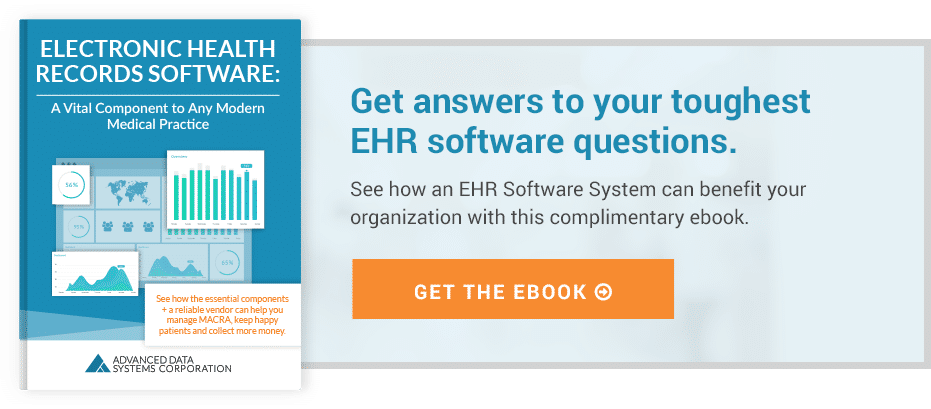4 Problems With Electronic Health Records
You and fellow stakeholders at your medical organization have done your due diligence and determined that now is the time to switch over from an antiquated paper-based system for handling patient information and are now ready to deploy Electronic Health Records software.
However, before you choose a vendor and EHR system to install, there are potential issues that you should be aware of. In particular, it’s prudent to consider security problems, reductions in data flow, the need for extra staff training, and the prospect of slowdowns for novices when inputting patient data in the first place.
Understanding the following four problems with electronic health records will help you when it comes time to install and use your own EHR system.
Security Risks From Criminal Computer Hackers
Electronic health records software presents a tempting target to hackers. Ever since Congress enacted the Health Insurance Portability and Accountability Act (HIPAA) in 1996, organizations with an EHR are required to safeguard sensitive patient information from computer criminals bent on breaking into the system.
Otherwise, you face lawsuits from patients if their information is compromised. Another risk to keep in mind is the prospect of electronic records being hijacked by crackers who hold the patient data hostage, encrypted until you pay the ransomware fee to unlock the information.
Make sure that you verify with your potential software provider about how the patient records will stay secure. A security audit of your organization by a third party will prove enormously beneficial in beefing up your system. It’s better to identify risk now before the patient records move into your EHR.
Data Bottlenecks Because of a Poorly Designed Interface
Electronic health records are designed to streamline your workflow. However if the EHR was created by developers with little regard for how it is to be used in real-world situations, the interface may be clunky and difficult to work with. This means staff could take much longer than needed to enter basic information or retrieve the proper record.
Look for EHR software that is easy and intuitive to use. Helpful menu systems and other commands should be available immediately as needed, without your workers having to hunt around for the next command or option. The fewer mouse clicks and keystrokes they need to enter to finish the patient record, the sooner they can move to the next one in line. So make sure that you read software reviews by trusted experts and arrange for a demo of the EHR software so you can test it for yourself.
Staff Needs Training to Switch from Paper to Electronic Health Records
Making the transition from old-fashioned paper records to a new electronic health care record system will entail some additional work for your staff at the outset. It’s very likely they will need some instruction in using the new EHR.
One option is to select the most computer-savvy members of your team and arrange for them to undergo comprehensive training first. They will likely require less time to get up to speed than your average employees. Additionally, they can help teach the rest of your team the tricks and techniques they pick up during training, which speeds up the software implementation even more.
It’s also a good idea to check out how responsive the software provider is to your questions about setting up and using the EHR. See the response time when messaging their help desk.
Individuals With Poor Typing Skills May Be Slowed Down Using an EHR
There are plenty of jokes about physicians with poor penmanship scrawling out messy, illegible prescriptions. With electronic prescriptions tied into your EHR system, such issues will be a problem of the past. But still, some of your employees may very well have poor typing skills. This means they could be slowed down a bit when putting new patient information into the electronic record.
A couple of solutions to these problems should be available in the EHR you’re considering installing: templates and speech recognition capability.
Templates for patient-specific situations are enormously helpful when putting in new information about a patient. A template helps guide the healthcare professional when typing in details concerning the patient’s insurance status, historical data, and the reasons for the current visit. With less time spent searching for where to put the information and fewer chances to omit needed information, templates are a great way to save time and increase accuracy.
For individuals with limited typing ability, there’s no need to put up with hunt-and-peck data input. If your electronic health record system includes an option for speech recognition, a doctor or nurse simply speaks, and the sounds are converted automatically into computer-readable text. This is a significant saving in time and money over typing it in slowly yourself or hiring off-site human transcribers to do this chore overnight.
Preparing Your Organization to Deploy an Electronic Health Records System
Your organization is on its way to becoming more streamlined and efficient once you install and start using a new electronic health records system. Just make sure everyone is aware of potential pitfalls that could initially slow down your operations when employees start using the new EHR. You can quickly get up to speed on the nuances of EHR usage, by clicking here to download our free ebook, “Electronic Health Records Software: A Vital Component to Any Modern Medical Practice."
Key Takeaways:
- Switching from a paper-based system to electronic health records carries an inherent risk of computer hackers stealing information, so you must safeguard against data criminals.
- An EHR with a badly designed interface can slow staff work down to a dull grind, so you should select a system that’s been developed by experts devoted to efficiency and ease of use.
- During the transition from paper records to EHR, your staff may need to go through training. Consider sending your most computer-literate workers for instruction, so they can help teach remaining workers who are less skilled.
- Inputting patient information into the EHR system can be a chore for doctors and nurses with poor typing ability. However, you can use speech recognition to speed up EHR data input.
About Christina Rosario
Christina Rosario is the Director of Sales and Marketing at Advanced Data Systems Corporation, a leading provider of healthcare IT solutions for medical practices and billing companies. When she's not helping ADS clients boost productivity and profitability, she can be found browsing travel websites, shopping in NYC, and spending time with her family.







